Related Research Articles
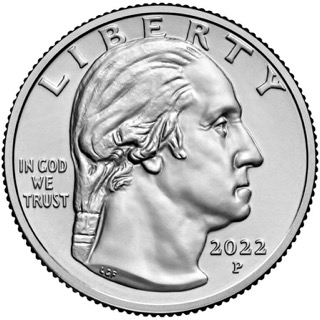
The quarter, short for quarter dollar, is a United States coin worth 25 cents, one-quarter of a dollar. The coin sports the profile of George Washington on its obverse, and after 1998 its reverse design has changed frequently. It has been produced on and off since 1796 and consistently since 1831.
Mint-made errors are errors during the minting process. Groups of coins with distinctive characteristics are known as varieties. The term variety applies to coins with both intended and unintended differences while the term error refers only to coins with unintended differences. Nevertheless, not all errors are varieties. Although there may be many identical examples of some errors, others are unique. For example, there may be many indistinguishable examples of coins with a specific die crack, while off-center strikes tend to be unique. Being unique does not mean that an error is valuable. Although no other coin may be similar to a coin with an off-center strike, off-center strikes happen often enough that buyers can choose from many examples each of which varies slightly from the other. Mint error coins can be the result of deterioration of the minting equipment, accidents or malfunctions during the minting process, or intentional interventions by mint personnel. Accidental error coins are perhaps the most numerous and in modern minting are usually very rare, making them valuable to numismatists. Intentional intervention by mint personnel does not necessarily include a deliberate attempt to create an error, but usually involves an action intended to improve quality that miscarries and creates error coins instead. Errors can be the result of defective planchets, defective dies or the result of mistakes made during striking. The planchet, die, and striking classification system happens to correspond with the mintmarks of the three largest U.S. mints, Philadelphia, Denver, and San Francisco. Not all errors fall neatly within the categories. Sometimes design elements are missing from coins because die crevices are filled with grease. Labels used to identify specific categories of errors sometimes describe the cause of the error. Other errors names describe what the viewer sees when looking at the coin while others have names that were adapted for use. The result is that some errors are known by multiple names. Filled die errors are also known as missing design element errors and as strike throughs. As is noted below under the discussion of missing design element coins, some errors have multiple causes. A rare error that sold for $5462.50 on Heritage Auctions in August 2010 is an undated U.S nickel struck on top of a 1960 5 centavos. Foreign coins struck on a U.S coin planchet or vice versa are very uncommon and hold a high value.

The 50 State quarters was a series of circulating commemorative quarters released by the United States Mint. Minted from 1999 through 2008, they featured unique designs for each of the 50 US states on the reverse.
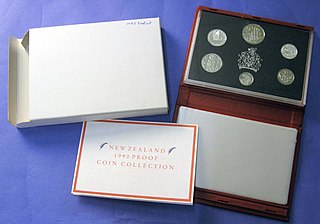
Proof coinage refers to special early samples of a coin issue, historically made for checking the dies and for archival purposes. Nowadays proofs are often struck in greater numbers specially for coin collectors (numismatists). Nearly all countries have issued proof coinage.
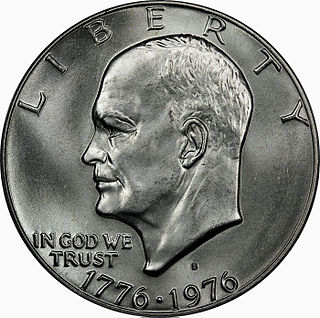
The United States Bicentennial coinage is a set of circulating commemorative coins, consisting of a quarter, half dollar and dollar struck by the United States Mint in 1975 and 1976. Regardless of when struck, each coin bears the double date 1776–1976 on the normal obverses for the Washington quarter, Kennedy half dollar and Eisenhower dollar. No coins dated 1975 of any of the three denominations were minted.

The quarter, short for quarter dollar, is a Canadian coin worth 25 cents or one-fourth of a Canadian dollar. It is a small, circular coin of silver colour. According to the Royal Canadian Mint, the official name for the coin is the 25-cent piece, but in practice it is usually called a "quarter", much like its American counterpart. In French, it is called a caribou or trente sous. The coin is produced at the Royal Canadian Mint's facility in Winnipeg, Manitoba.
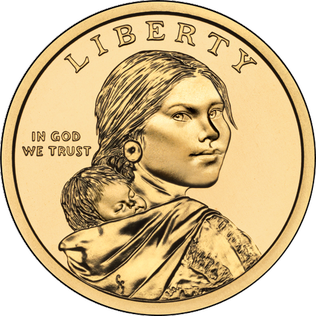
The Sacagawea dollar is a United States dollar coin introduced in 2000, although not minted for general circulation between 2002 and 2008 and again from 2012 onward because of its general unpopularity with the public and low business demand for the coin.
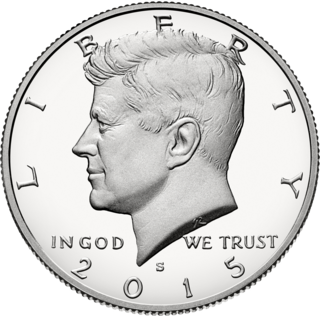
The Kennedy half dollar, first minted in 1964, is a fifty-cent coin issued by the United States Mint. Intended as a memorial to the assassinated 35th president of the United States John F. Kennedy, it was authorized by Congress just over a month after his death. Use of existing works by Mint sculptors Gilroy Roberts and Frank Gasparro allowed dies to be prepared quickly, and striking of the new coins began in January 1964.
This glossary of numismatics is a list of definitions of terms and concepts relevant to numismatics and coin collecting, as well as sub-fields and related disciplines, with concise explanations for the beginner or professional.

The silver real was the currency of the Spanish colonies in America and the Philippines. In the seventeenth century the silver real was established at two billon reals or sixty-eight maravedís. Gold escudos were also issued. The coins circulated throughout Spain's colonies and beyond, with the eight-real piece, known in English as the Spanish dollar, becoming an international standard and spawning, among other currencies, the United States dollar. A reform in 1737 set the silver real at two and half billon reals or eighty-five maravedís. This coin, called the real de plata fuerte, became the new standard, issued as coins until the early 19th century. The gold escudo was worth 16 reales de plata fuerte.
Since the 1976 Summer Olympics in Montreal, the Royal Canadian Mint has struck Summer and Winter Olympic coins to mark Games held in Canada.

The Coinage Act of 1965, Pub. L. 89–81, 79 Stat. 254, enacted July 23, 1965, eliminated silver from the circulating United States dime and quarter dollar coins. It also reduced the silver content of the half dollar from 90 percent to 40 percent; silver in the half dollar was subsequently eliminated by a 1970 law.

The Washington quarter is the present quarter dollar or 25-cent piece issued by the United States Mint. The coin was first struck in 1932; the original version was designed by sculptor John Flanagan.

Coin roll hunting is the hobby of searching and sorting coinage pulled from circulation for collectible coins. This is achieved through obtaining rolled coin, boxed coin, or bagged coin from banks and credit unions. A variant of this practice involves banknotes and is carried out in essentially the same fashion, normally to search for unusual serial numbers, star notes, and misprints.
Minting, coining or coinage is the process of manufacturing coins using a kind of stamping, the process used in both hammered coinage and milled coinage. This "stamping" process is different from the method used in cast coinage.
A die defect is a unique and unintentional flaw in a coin die and is created through excessive use or polishing of the die. A die bearing such a defect is occasionally referred to as a defective die. Generally, and depending upon the magnitude of the defect, coins that are produced from these dies are considered error coins. Also, the term encompasses a wide variety of design errors that were engraved into the die originally and were slipped into circulation before the incorrect design was discovered.
US error coins are error coins produced by the US government. There are three categories of error coins as provided by the American Numismatic Association. Metal usage and striking errors referred to widely as planchet errors, die errors, and mint striking errors. This does not include the varieties that the US Mint has issued over the years.
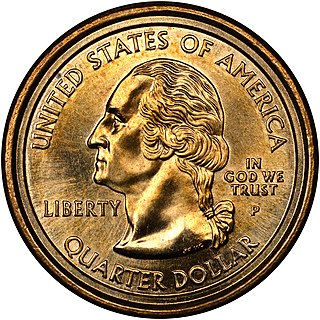
The 2000 Sacagawea dollar – Washington quarter mule is an error coin featuring the obverse of a Washington quarter and the reverse of a Sacagawea dollar struck on a gold-colored dollar coin planchet. It is one of the first known authentic mule coins to be released into circulation by the United States Mint.
Below are the mintage figures for the 50 State quarters.
References
- ↑ mcmorrowhernandez (2009-04-29). "Wisconsin Error Quarters: Yes, They Can Be Found In Circulation... Look For The Extra Leaf On Wisconsin Quarters!". U.S. Coins Guide. Retrieved 2022-04-17.
- ↑ "State Quarter Errors: Wisconsin State Quarter Error, Off-Centered Strike, etc". www.us-coin-values-advisor.com. Retrieved 2022-04-17.
- ↑ "State Quarter Errors: Wisconsin State Quarter Error, Off-Centered Strike, etc". www.us-coin-values-advisor.com. Retrieved 2022-04-17.